Mission Furniture from the Arts & Crafts Movement epitomizes simplicity, integrity, and handcrafted quality. This style emerged as a response to Victorian excess and industrialization, championing natural materials and skilled craftsmanship. Mission pieces boast sturdy, functional designs, square legs, and exposed joinery, reflecting a commitment to honesty and durability. Crafted from solid oak, cherry, maple, or walnut, they emphasize the beauty of wood grain and traditional techniques. Embracing simplicity, Mission Furniture exudes timeless charm and practicality, resonating with those who appreciate authentic artisanship. Discover more about the enduring appeal and exquisite details of Mission Style.
Key Takeaways
- Mission furniture embodies Arts & Crafts values of simplicity and natural materials.
- Crafted with integrity, showcasing traditional joinery techniques and sturdy construction.
- Features solid American white oak and black cherry for durability and timeless appeal.
- Rejects excessive ornamentation for a focus on wood grain details and handcrafted finishes.
- Embraces functional design elements for practicality and longevity in living spaces.
Origins of Mission Furniture
Mission furniture originated during the early 20th century from the Arts & Crafts movement, which emphasized simplicity and natural materials.
The term 'Mission' was coined by Joseph McHugh in New England after being inspired by a chair in a San Francisco church. This style of furniture served as a response to the excessive ornamentation of Victorian design and the devaluation of handmade goods brought about by the industrial revolution.
With design principles centered around integrity, truth to materials, and a deliberate rejection of ornate Victorian styles, Mission furniture embraced simplicity, durability, and the celebration of the natural beauty of wood.
Joseph McHugh's influence in naming the style highlights the movement's dedication to honoring craftsmanship and showcasing the inherent qualities of materials.
Through the development of Mission furniture, the Arts & Crafts movement sought to revive appreciation for the artistry and authenticity of handmade goods in a time of mass production and industrialization.
Characteristics of Arts & Crafts Style
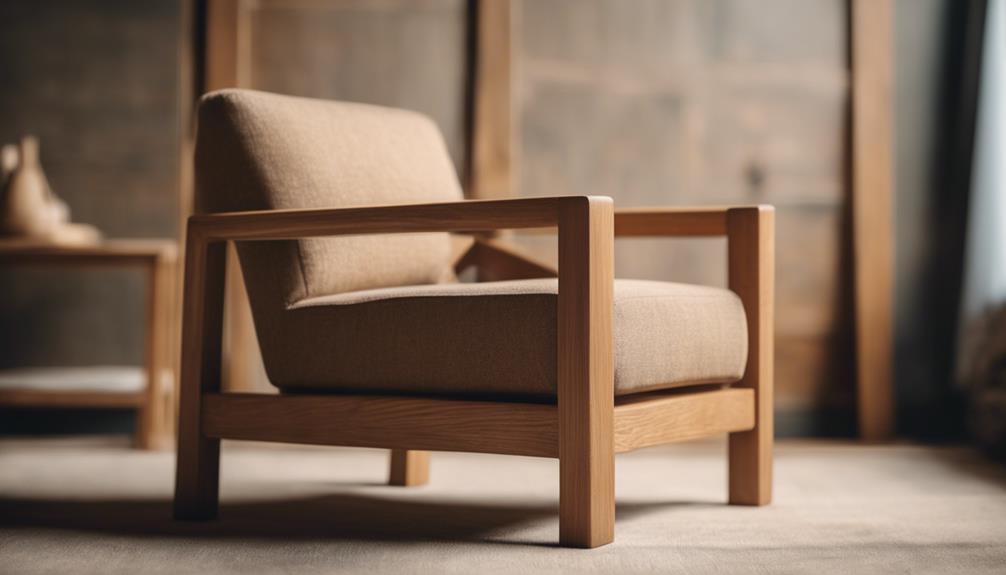
The Arts & Crafts style is characterized by an emphasis on craftsmanship, simplicity, and natural materials. Rectilinear forms, exposed joinery, and handcrafted details are hallmarks of this design aesthetic.
Within this style, Mission furniture stands out for its sturdy, functional designs that reject mass-produced goods in favor of celebrating the beauty of wood grain and artisan craftsmanship.
Design Elements
Emphasizing sturdy construction and simplicity, Arts & Crafts style furniture features chunky designs with straight lines and 90-degree angles. This design ethos extends to various elements commonly found in this style:
- Square or rectangular legs: Adding to the robust and straightforward look of the furniture.
- Spindles: Often used in chair backs and sides, showcasing a touch of craftsmanship and detail.
- Emphasis on durable construction: Ensuring longevity and functionality in everyday use.
- Prioritization of simplicity and integrity: Reflecting the movement's rejection of excessive ornamentation and focus on honesty in design.
- Highlighting natural wood characteristics: Quartersawn white oak, a popular choice, displays distinctive grain patterns and durability in Arts & Crafts pieces.
Mission furniture, synonymous with Craftsman style furniture, emerged as a response to the industrialization that devalued handmade goods during the Arts & Crafts movement.
The terms Mission, Arts & Crafts, and Craftsman are often used interchangeably, embodying ideals of simplicity and truth to materials.
Material Choices
Arts & Crafts style furniture showcases a preference for solid oak, cherry, maple, or walnut due to their durability and natural beauty, reflecting a commitment to quality materials in design. Mission furniture from the Arts & Crafts movement is characterized by its sturdy, heavy, and chunky appearance, often featuring straight lines, squared legs, and an emphasis on the natural wood grain of these materials.
The design elements of Arts & Crafts style furniture commonly include spindles, mortise-and-tenon joinery, and simple, functional construction techniques that highlight the intrinsic beauty of the chosen wood. This style exudes a timeless appeal, embodying simplicity and integrity in its craftsmanship.
Artisan Craftsmanship
Craftsmen within the Arts & Crafts movement prioritize handcrafting furniture with a focus on simple, clean lines and sturdy construction techniques. The artisan craftsmanship found in Arts & Crafts style emphasizes the use of high-quality materials and traditional joinery methods like mortise-and-tenon joints.
When it comes to creating pieces like an entry cabinet, the following characteristics are key:
- Handcrafted Excellence: Each piece is meticulously handcrafted, showcasing the dedication and skill of the artisan.
- Sturdy Construction: Furniture is built to last using time-tested construction methods for durability.
- Natural Materials: Craftsmen value the use of natural materials, celebrating the beauty of wood grain.
- Simple, Clean Lines: Designs feature straightforward, unadorned lines for a timeless aesthetic.
- Attention to Detail: Every aspect of the furniture, from the joinery to the finish, is meticulously attended to for a high-quality end product.
Iconic Mission Furniture Pieces
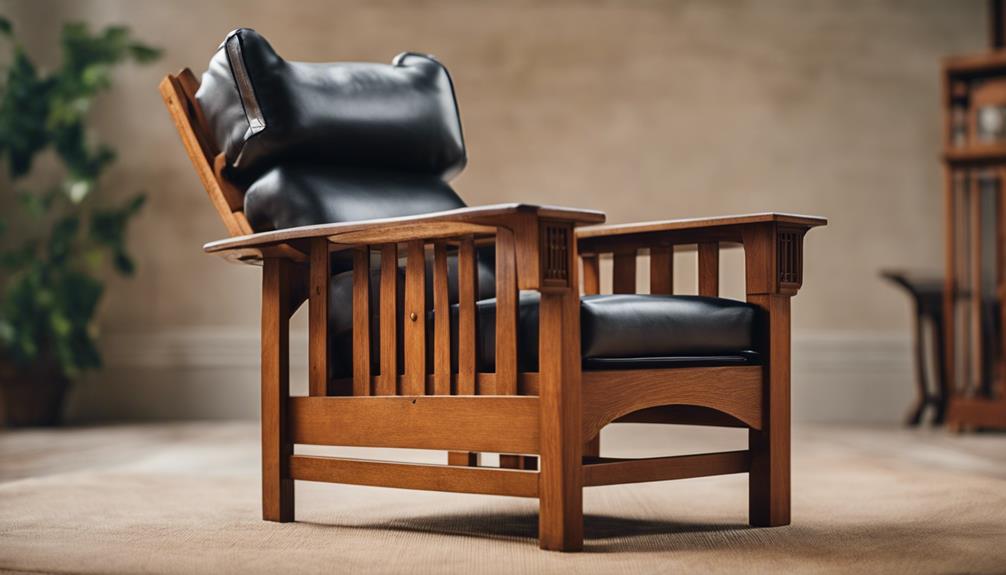
Iconic Mission furniture pieces, such as the Morris chair and side tables, are revered for their elegant yet simple designs and sturdy construction. These pieces showcase the essence of the Arts & Crafts movement, emphasizing clean lines and the natural beauty of wood. The Morris chair, known for its adjustable back and wide armrests, embodies comfort and functionality. Side tables complement these chairs with their practicality and timeless appeal, making them versatile additions to any living space.
| Iconic Mission Furniture Pieces | Description |
|---|---|
| Morris Chair | Adjustable backrest and wide armrests for comfort. |
| Side Tables | Practical and timeless design, perfect for various spaces. |
These iconic pieces reflect the values of the Arts & Crafts movement, where craftsmanship and simplicity reign supreme. The durability and classic design elements of Mission furniture ensure that these pieces will continue to be cherished for generations to come.
Materials Used in Mission Furniture
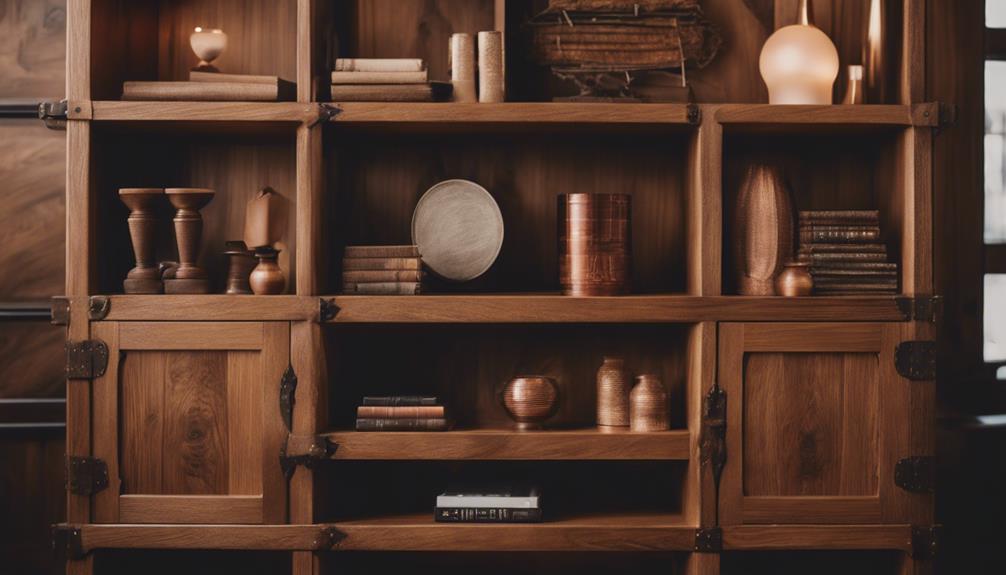
Mission furniture primarily uses solid American white oak and American black cherry, renowned for their durability and unique characteristics.
Crafted with a focus on simplicity and sturdiness, these materials are meticulously handcrafted in Upstate New York.
The careful craftsmanship, including mortise-and-tenon joinery, guarantees the furniture's longevity and strength.
Wood as Primary Material
Mainly crafted from solid American white oak and black cherry, Mission furniture highlights the natural beauty and durability of these wood species. Crafted in Upstate New York, each piece showcases unique ray flake patterning in oak and a rich patina in cherry.
The furniture features mortise-and-tenon joinery, quadralinear posts, and side-hung, center-guided drawers for durability and functionality. Hand-applied finishes are meticulously done to highlight wood grain details and various tones, enhancing the natural beauty of the wood species.
The emphasis on natural materials and craftsmanship guarantees longevity and timeless appeal in Mission furniture pieces.
- Solid American white oak and black cherry are the primary wood materials used in Mission furniture.
- Crafted pieces from these woods feature distinctive patterns and rich patinas.
- The furniture is designed with durability in mind, utilizing specific joinery techniques for longevity.
- Hand-applied finishes are meticulously done to enhance the natural beauty of the wood.
- The focus on craftsmanship and natural materials promises timeless appeal and longevity in Mission furniture pieces.
Simple yet Sturdy Design
Craftsmen crafting Mission furniture prioritize utilizing solid American white oak and black cherry to emphasize the natural beauty and durability of these wood species. These materials are carefully selected for their strength and longevity, characteristics that define the simple yet sturdy design of Mission furniture.
Quarter-sawn oak and cherry are commonly used in crafting Mission furniture, showcasing their natural grains and robust quality. To guarantee the furniture's durability, craftsmen employ traditional techniques like mortise-and-tenon joinery and quadralinear posts, enhancing the structural integrity of each piece.
Additionally, hand-applied finishes are meticulously added to highlight the wood grain details and accentuate the intrinsic beauty of these hardwoods. The emphasis on utilizing materials like oak and cherry not only enhances the aesthetic appeal of Mission furniture but also contributes to its timeless and classic allure, making it a popular choice for those seeking both style and durability in their home furnishings.
Handcrafted With Care
Handcrafted with meticulous attention to detail, Mission furniture utilizes the highest-quality hardwoods like solid American white oak and black cherry for durability and natural beauty. Craftsmen employ traditional techniques such as mortise-and-tenon joinery and quadralinear posts to guarantee strength and longevity.
The furniture's functionality is enhanced by features like side-hung, center-guided drawers. Clear, hand-applied finishes are meticulously added to highlight the intricate wood grain details and bring out the inherent beauty of the wood species.
Antiqued metal finishes are used for hardware, including vintage Mission styles like bail pulls and hammered knobs, contributing to the overall charm and aesthetic of the pieces. Mission furniture maintains a timeless appeal with the use of quartersawn white oak for a striking deep grain appearance and cherry wood for a subtle grain and rich patina, staying true to the classic Mission style.
Craftsmanship in Mission Designs
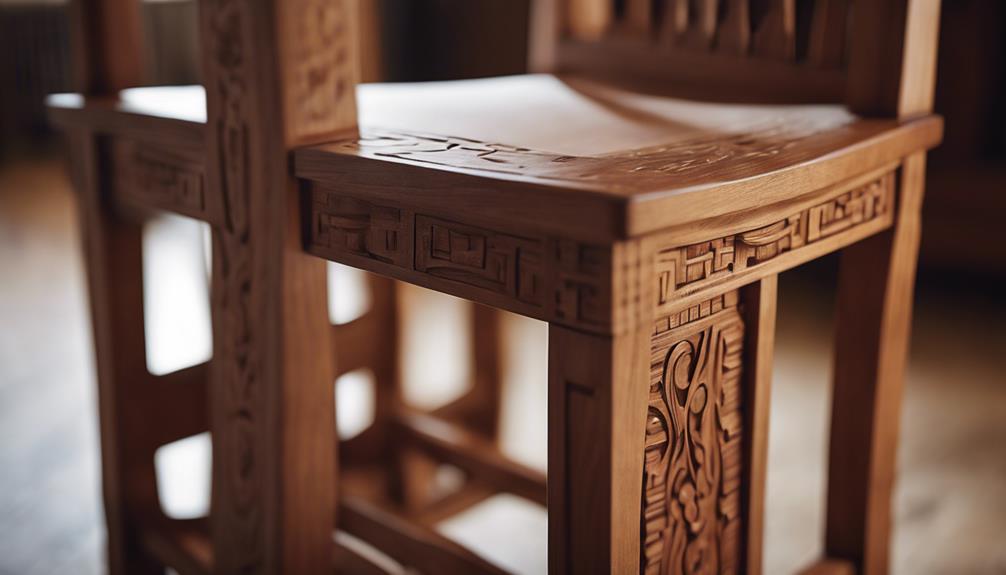
Mortise-and-tenon joinery stands as a hallmark of Mission furniture craftsmanship, ensuring durability and longevity in the design. The use of this technique not only enhances the aesthetic appeal of Mission pieces but also provides structural integrity, making them sturdy and long-lasting.
In addition to mortise-and-tenon joinery, Mission designs often feature quadralinear posts that contribute to the strength of the furniture, ensuring that each piece is robust and able to withstand the test of time.
Additionally, the inclusion of side-hung, center-guided drawers in Mission furniture showcases the meticulous attention to detail that craftsmen like Leopold Stickley put into their work, ensuring that functionality is paired with beauty in each piece.
Natural Beauty in Mission Furniture

Highlighting the inherent elegance of wood grain details, Mission furniture captivates with its natural beauty and hand-applied finishes. Crafted with precision and care, this style of furniture showcases the following characteristics:
- Wood Grain Details: Mission furniture emphasizes the natural patterns and textures of wood, enhancing its beauty.
- Hand-Applied Finishes: Each piece is meticulously finished by hand, allowing for a unique touch and clarity that enriches the wood's appearance.
- Quality Materials: Utilizing solid American white oak and black cherry, Mission furniture exudes durability and sophistication.
- Functional Design Elements: Features like mortise-and-tenon joinery and side-hung, center-guided drawers not only add to the aesthetic appeal but also guarantee practicality and longevity.
- Hardware Choices: From antiqued metal finishes to vintage Mission hardware styles like bail pulls and hammered knobs, the hardware complements the overall charm of Mission furniture.
Through these elements, Mission furniture achieves a timeless allure that celebrates the natural beauty of the materials used in its creation.
Timeless Appeal of Mission Style
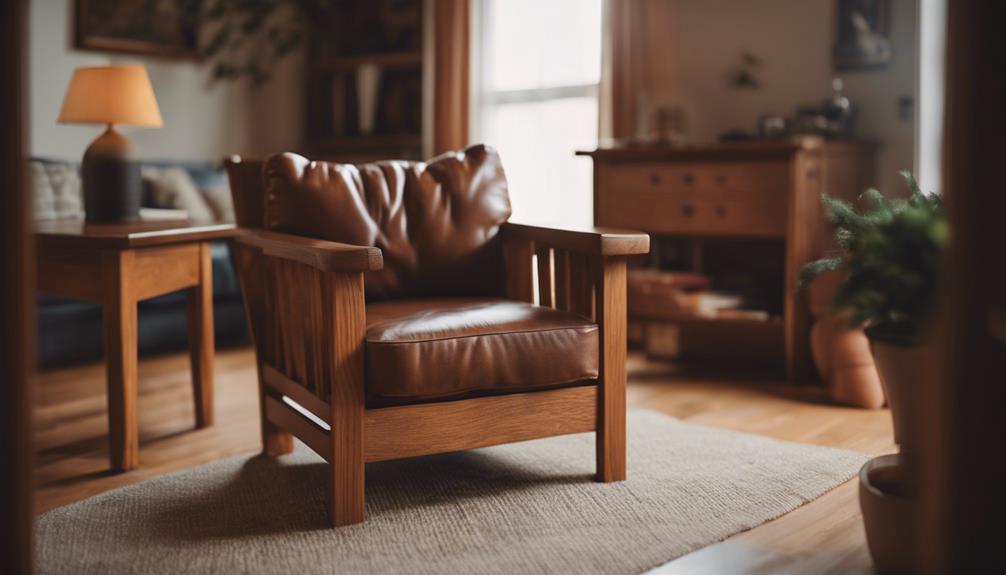
The timeless appeal of Mission style furniture lies in its enduring design principles and craftsmanship. Originating from the Arts & Crafts movement in the early 20th century, Mission furniture embodies characteristics such as straight lines, square legs, and a focus on simplicity and natural wood elements.
Its sturdy and heavy appearance, with 90-degree angles and durable construction, reflects the movement's core values of integrity and honest craftsmanship. Popular for its classic aesthetic, Mission style furniture exudes a sense of authenticity in both materials and design, resonating with those who appreciate traditional artisanship.
The enduring popularity of Mission furniture can be attributed to its timeless design language that transcends fleeting trends, making it a staple in many homes. By embracing the simplicity and integrity of Mission style, individuals can bring a touch of history and enduring beauty into their living spaces.
Finishes and Hardware Choices

When considering Mission furniture, the finishes and hardware choices play an important role in enhancing its overall aesthetic appeal and authenticity. Mission furniture finishes emphasize the natural beauty of wood grain details, creating a timeless and classic look.
Hardware choices often include antiqued metal finishes like bail pulls and hammered knobs, adding a rustic and vintage charm to the pieces. The unique clarity in Mission finishes enhances the overall beauty of the furniture, showcasing the craftsmanship and quality materials used.
Vintage Mission hardware styles further contribute to the authenticity of the pieces, reflecting the traditional Arts & Crafts Movement design elements. Ultimately, the finishes and hardware selections are key factors that contribute to the enduring appeal and elegance of Mission style furniture.
Where to Find Mission Furniture
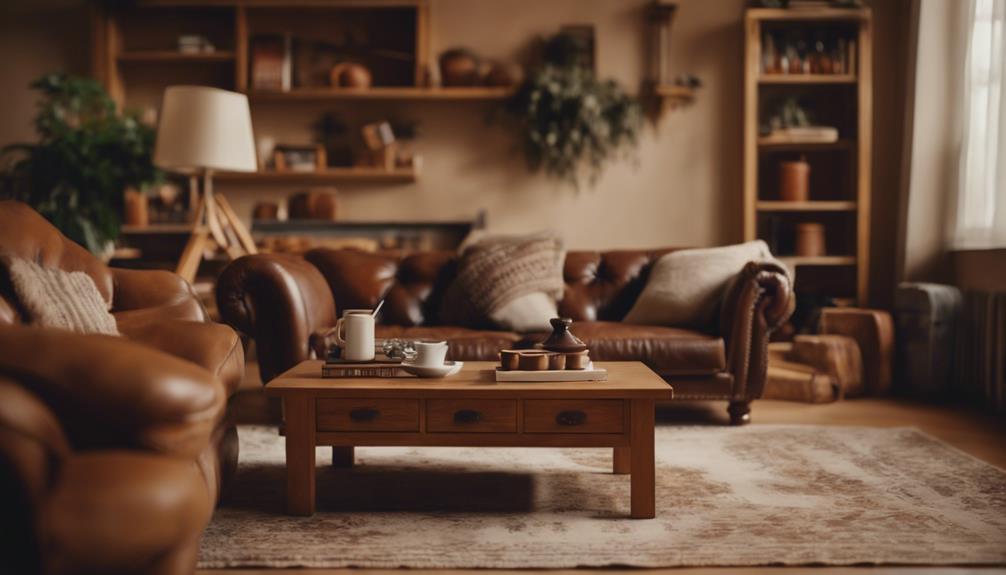
Seek out specialty furniture stores and online retailers to discover a range of Mission furniture pieces inspired by the Arts & Crafts movement. Crafted with an emphasis on simplicity and natural materials, Mission furniture exudes timeless appeal through its straight lines, sturdy construction, and classic design elements. When searching for Mission furniture, look for pieces made from high-quality hardwoods like oak, cherry, walnut, and maple to guarantee durability and authenticity.
Specialty furniture stores often carry a selection of Mission furniture, allowing you to see and feel the pieces in person before making a purchase. Online retailers also offer a convenient way to browse through various styles and compare prices from the comfort of your own home.
Whether you're looking for a Mission style dining table, a cozy armchair, or a classic bookcase, both physical stores and online platforms provide a diverse array of options to suit your needs. With its versatility and functionality, Mission furniture can add a touch of timeless elegance to any room in your home.
Frequently Asked Questions
What Is the Difference Between Arts and Crafts and Mission Furniture?
Arts and Crafts furniture is known for its intricate details and decorative elements, highlighting the craftsmanship and artistry of the maker.
In contrast, Mission furniture focuses on simplicity and functionality, featuring straight lines, 90-degree angles, and sturdy construction.
While both styles share roots in the Arts and Crafts movement, they differ in their design aesthetics and emphasis, with Arts and Crafts furniture leaning towards ornate beauty and Mission furniture prioritizing practicality and minimalism.
What Are the Characteristics of Mission Style Furniture?
Mission style furniture is characterized by its sturdy, chunky appearance with straight lines, square legs, and spindles. It emphasizes durability, simplicity, and natural wood features, embodying the Arts & Crafts movement's focus on handmade goods and natural materials.
The design showcases 90-degree angles and functionality over ornate embellishments. This style exudes a timeless aesthetic that merges craftsmanship with practicality, making it a popular choice for those seeking a blend of form and function in their furniture.
What Era Is Mission Style Furniture?
Mission style furniture originated during the Arts & Crafts movement in the early 20th century. It reflects a return to craftsmanship and authenticity, popular between 1900 and 1915.
The style is characterized by sturdy, heavy, and chunky designs with straight lines and square or rectangular legs. Emphasizing simplicity, integrity, and the natural characteristics of wood, Mission furniture represents a shift away from the excesses of Victorian style and the devaluation of handmade goods during the industrial revolution.
Is Mission Style Furniture Still Popular?
Yes, mission style furniture remains popular due to its timeless design and enduring appeal to traditional and arts & crafts design enthusiasts.
The sturdy construction, straight lines, and emphasis on natural wood characteristics contribute to its continued popularity among homeowners.
Crafted with quality materials and attention to detail, mission style furniture extends to various pieces like benches, nightstands, sideboards, and buffets, making it a sought-after choice for those seeking durability and classic aesthetic charm in their interiors.
Conclusion
To sum up, Mission furniture from the Arts & Crafts movement continues to be a popular choice for those seeking timeless, handcrafted pieces with a focus on simplicity and functionality.
According to a study by the American Craft Council, over 60% of consumers prefer furniture with traditional craftsmanship over mass-produced items.
This highlights the enduring appeal of Mission style furniture, with its emphasis on quality materials, skilled craftsmanship, and a connection to the natural world.








